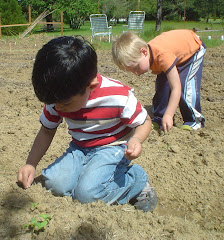Hay-bale, slow-cook compost pile
One of our readers noticed this picture on our website of a hay-bale compost bin and was curious about making one. This kind of compost pile is ideal for the following conditions:
- You have plenty of room (depending on size of hay bales, its "footprint" can be as big as 5' x 8').
- You have enough time to leave it alone for several months while it slowly decomposes.
If your situation meets these criteria, here's how to make one:
Make a box of hay-bales.
Important: Before you make a hay-bale compost bin, please read our post about Herbicide Contamination of Compost, Manure and Mulch
You can start this hay-bale compost any time of year but its ideal if you make it in the fall as you're putting your garden to sleep for the winter and will have large quantities of plant-matter. Lay your hay-bales in a rectangle, one layer high. As you pull up your squash, corn, tomatoes etc toss them in the pile. If you're putting in "woody" material or thick stalks (corn, sunflower etc) they will break down faster if you cut them into smaller pieces with a machete or pruners. Mix in some rotting apples or kitchen scraps (vegetable matter only please) to attract red wriggler composting worms. Since the pile will shrink by at least half over the winter, pile it high, stomping it down as you go. Put a tarp over the pile once the winter rains start and by spring you'll have a beautiful pile of organic matter to nourish the new plants you're transplanting into the garden.
Sifted compost to nourish transplants - put a big handful in as you plant them.
Do not put in grasses from your garden that can grow from bits of their roots. For example: Bermuda grass or Quack grass etc. This is a slow-cook pile and its not hot enough to kill these weeds. If you put them in the compost you will then spread them all through your garden when you "harvest" the compost!
Sifter with hinged legs. It can be moved to sift different piles of material in your garden.
One last step... In order to separate out the composted goodies from the materials that didn't break down over the winter, you'll need to make a sifter. Chris built the one above from lumber scraps we had leftover from other projects and some half-inch "hardware cloth" (wire mesh). The legs are attached with hinges so it can be folded up to move and also set at different angles. A simpler sifter can be made to fit over your wheelbarrow or garden cart - half-inch holes are ideal. Using our sifter, we place a tarp below it. You'll find it will work best if you use a spade-fork to break the compost pile into smaller clumps before tossing them onto the sifter.
The hay bales rot and decompose throughout the whole winter and make incredible sheet-mulch to put around your transplants in the spring. You'll notice as you peel off the 2-3 inch "flakes" (they're pretty gooey by spring-time!) that they are full of red worms, their eggs and castings. Your spring garden now will be infused with a new, healthy population of these mini-livestock.
You will likely have many "volunteers" from the seeds of the plants you threw into your compost pile in the fall. Don't worry!You can easily weed them out if they come up in your garden beds.
Unsung heroes!
And now for local news:
Our current wish list: Our biggest need now is for a large quantity of spoiled hay and/or grass clippings (for mulch). Ideally we'd appreciate it if you can deliver them to the Monroe site but if you have materials and no transportation, perhaps we can gather a crew to come pick up your donation. Give us a call if you can help us. Chris and Llyn - (541) 847-8797
Extra plants to give away: There are some tomato starts, SMR 58 Pickling Cukes, two Red Kuri squash (a winter/storage variety) and a few pots of chives that need homes. Look on the picnic table behind the picnic pavilion at Alpine. Please don't take plants off any other tables or out of the garden as these may be donations to the garden we haven't seen yet. We had over 250 onion sets that were left on a different picnic table...if you took them by mistake and haven't planted them in your garden yet, please bring them back or share the harvest with your friends and neighbors (smile).
Gary Watts mowing Alpine Chapel Park
We have much to be thankful for this month, in spite of spells of rainy weather, volunteers Rann and Doreen have showed up weekly to help us with making tomato cages, transplanting and mulching the gardens. Gary Weems has continued to assist with the construction of the garden shed in Alpine. With just a bit of trim-work and painting, it's done. We've already begun filling it with tools and garden supplies. Steve Rose, Larry Hammon and Greg and Marilyn Palmer have donated a variety of tomato plants to the gardens. We've planted as much as we have room for (close to 200 plants!) and there are still some left over. Jan Fanger donated some interesting blue and red sprouting potatoes which we'll be planting down in Monroe. We've got a whole neighborhood effort bringing us grass clippings in Alpine: Thanks to: Curtis, Aubrey, Phil and his partner Jorie for helping us keep Alpine mulched. Bud Hardin has come on board with a generous $200 donation, fencing material we're using for tomato cages and a huge load of pots and flats for the greenhouse. Gary and Dorothy - of Alpine Pump spent a good portion of their day mowing the Alpine Park with a mower loaned to us from Diamond Woods Golf Course-great job you guys! Jack Jones showed up that same day and tinkered on our donated lawn-mower to help us get it running better.

Dorothy Brinckerhoff mowing the center-lawn at Alpine's garden
Evelyn Lee donated us a string-trimmer she no longer needed and we've got that running now. Renee Duncan answered the call for a person to oversee the perennial beds in Alpine. We'll be using the volunteers' back-power to help her keep the flowering shrubs and flowers beds looking nice but its great to have someone oversee things. Renee also contributed some squash and pumpkin plants. Chester Crowson had a new pump installed at the Monroe site. We'll have 10-15 gallons a minute down there which will be great once summer finally gets here! Last but not least, Eva Fife has found a Philomath connection for some horse poop which she loaded and delivered to the Monroe site. The squash plants thank you, Eva! As you can see, the gardens are truly becoming a community effort. We do our best to acknowledge everyone personally for their contributions. If we have overlooked you, please send us an email so we can include you in the next post. Every bit helps!

Jack Jones tinkering with mower donated by Ray Kreth and Mylrea Estell




















































